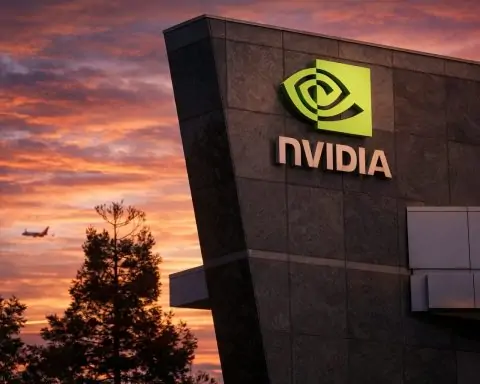- Bitcoin-fueled stock surge: MicroStrategy shares rallied in early October 2025 amid Bitcoin’s “Uptober” crypto surge. The stock jumped ~6% on Oct. 1 after a favorable crypto tax ruling, and traded around $355 by Oct. 3 (up from ~$338 at the week’s start) as Bitcoin hit all-time highs above $120,000 [1] [2].
- Massive 2025 outperformance: Year-to-date, MSTR is up roughly 15–20%, vastly outperforming the S&P 500 (which is up only ~5%) [3]. Over the past year the stock nearly quadrupled – from about $130 in Oct. 2024 to a ~$550 peak in mid-2025 – before settling back in the mid-$300s [4].
- World’s largest Bitcoin hoard: MicroStrategy now holds approximately 640,000 BTC (worth over $70 billion at current prices) on its balance sheet [5]. These holdings, accumulated over several years, were acquired at an estimated ~$46 billion total cost (around $70–73K per coin on average) [6] [7]. The company even added ~1,955 BTC (≈$217 million worth at ~$111K/BTC) in late September 2025, underscoring its ongoing accumulation strategy [8].
- Record-breaking profits: Fueled by Bitcoin’s rally and new fair-value accounting rules, MicroStrategy swung to a record $10.0 billion profit in Q2 2025 (April–June) [9] after several loss-making quarters. This blockbuster quarter was driven by a $14 billion unrealized gain on its crypto holdings [10]. Executives raised full-year 2025 guidance to ~$24 billion net income (~$80 EPS) if Bitcoin reaches ~$150K by year-end [11].
- Another profitable quarter: Q3 2025 is also expected to be solidly profitable. Analysts estimate around $2.9 billion in net income (~$10 per share) for the quarter, given Bitcoin’s climb from ~$107K to $114K during Q3 [12]. That would mark a second consecutive quarter in the black, meeting a key criterion for S&P 500 index inclusion (though the final decision rests with the index committee) [13].
- Bullish analyst outlook: Wall Street sentiment on MSTR is broadly positive despite the risks. ~15 analysts cover the stock with a “Moderate Buy” consensus (11 Buys, 2 Holds, 1 Sell) [14]. Recent 12-month price targets average in the $500–$560 range (~40–60% above the latest price), with the most bullish calls exceeding $700 [15]. Analysts see significant upside if Bitcoin continues climbing – but also caution that MSTR’s volatility will remain high [16].
- Pivot to a Bitcoin strategy: In 2025 MicroStrategy rebranded itself as “Strategy, Inc.” to emphasize its Bitcoin-focused mission [17]. The firm calls itself the world’s first and largest “Bitcoin treasury” company and has largely de-emphasized its traditional software business. Co-founder Michael Saylor is outspoken in his crypto conviction, stating “we’re in a hyper-growth, hyper-adoption phase for bitcoin as a treasury reserve asset” [18]. Rather than pursue software acquisitions, the company has been issuing equity and debt to raise funds for more Bitcoin purchases.
MSTR Stock Rallies on Bitcoin’s “Uptober” Boom
MicroStrategy’s stock price has been on a tear alongside the latest Bitcoin rally. On October 1, 2025, MSTR leapt about 6% intraday after the U.S. Treasury clarified that unrealized crypto gains will be excluded from the new 15% corporate minimum tax, meaning MicroStrategy won’t owe extra tax on its paper Bitcoin profits [19] [20]. This tax relief news – which removed a major overhang for crypto-heavy firms – sent the stock from roughly $322 to $343, and momentum carried through the week. By the close of Oct. 2, MSTR was at $352.33, and by mid-day Oct. 3 it reached around $355 [21]. Trading volume spiked well above average during this surge, reflecting heightened investor interest [22]. In comparison, the broader S&P 500 index rose only about 0.5% in that period, underscoring MicroStrategy’s high-beta response to crypto news [23].
Heading into October 6, MicroStrategy is riding strong tailwinds from Bitcoin’s exceptional run. Over the first week of October, Bitcoin’s price jumped roughly 10–11%, breaching new record highs around $125,000 [24]. Crypto enthusiasts have dubbed this rally “Uptober,” as the usually strong seasonal trends for Bitcoin appear to be playing out in 2025. This surge in the flagship cryptocurrency has directly boosted MicroStrategy’s stock, given the company’s enormous BTC holdings. In effect, MicroStrategy shares function as a leveraged proxy for Bitcoin – when Bitcoin rallies, MSTR typically rallies even more in percentage terms, and vice versa. It’s not uncommon for MSTR to swing several percentage points in a single day as it amplifies Bitcoin’s volatility. (The stock’s statistical beta is around 3.8, meaning it’s nearly four times more volatile than the overall market [25].) For example, on October 3 when Bitcoin jumped about 3% in the afternoon, MSTR shares also ticked higher in tandem [26]. This tight correlation works both ways, however, so any pullback in crypto prices could swiftly drag MSTR down.
Financial Performance, Earnings and Bitcoin Holdings
MicroStrategy’s financial results have dramatically improved in 2025 thanks to new accounting standards and Bitcoin’s price appreciation. The company adopted fair-value accounting for its digital assets this year, which means it now marks its Bitcoin holdings to market each quarter (recognizing unrealized gains or losses in earnings). As a result, when Bitcoin’s value surged in Q2 2025, MicroStrategy was able to record those paper gains as income.
Q2 2025 was a watershed moment – the company reported $10.0 billion in net income for the quarter [27], its first quarterly profit in about six quarters. This astonishing result was almost entirely due to a $14.0 billion unrealized gain on MicroStrategy’s Bitcoin trove as the coin’s price soared in the spring [28]. (By contrast, the firm’s actual business operations are tiny relative to these crypto gains – quarterly software revenues are around $114 million [29].) For context, MicroStrategy had been posting large losses in prior periods when it had to impair its Bitcoin holdings during price dips. Now, with fair-value accounting and a crypto bull market, the firm’s earnings have swung massively to the positive. The CFO even forecast full-year 2025 profits around $24 billion (roughly $80 earnings per share) if Bitcoin reaches approximately $150,000 by the end of December [30]. Such guidance implies expectation of continued Bitcoin strength into Q4.
Early indications suggest that Q3 2025 continued this profitable trend. Bitcoin’s price rose from about $107K at the start of Q3 (July) to around $114K by the end of September. According to analyst estimates, that jump should translate into roughly $2.9 billion in net income for MicroStrategy in Q3 (about $10 per share) [31]. If confirmed when the company reports official results (scheduled for October 30, 2025), it would mark MicroStrategy’s second consecutive profitable quarter – a notable turnaround from its prior string of losses. Importantly, two quarters of positive earnings mean MicroStrategy now meets one of the key criteria for S&P 500 index inclusion (a year of positive trailing earnings) [32]. The stock was passed over in the last index rebalancing (more on that below), but ongoing profitability keeps it in the conversation for future inclusion.
Underpinning these financial results is MicroStrategy’s massive Bitcoin holding, which dwarfs that of any other public company. As of late September 2025, the company held on the order of 640,000 bitcoins on its balance sheet [33]. At current market prices, that stash is valued around $70–75 billion – an immense asset base for a company with a ~$97 billion equity market cap. MicroStrategy’s coins were accumulated through dozens of purchases since 2020, at an aggregate cost of roughly $46 billion (averaging around $70K–$73K per BTC) [34] [35]. This means the firm’s average breakeven price is in the low-$70Ks per bitcoin. With BTC now well above $120K, MicroStrategy is sitting on very large unrealized gains (approximately +60% over cost basis) [36]. Every $1,000 move in Bitcoin’s price translates to roughly $640 million change in the value of MicroStrategy’s holdings – illustrating just how leveraged the company is to this single volatile asset.
MicroStrategy has aggressively raised capital to fund its Bitcoin acquisitions, rather than using its own cash flows (which are modest). In 2025 alone, the company issued over $10 billion of new stock and other securities to bring in money for crypto purchases [37]. For example, in July 2025 MicroStrategy launched a novel high-yield preferred stock (ticker STRC, nicknamed “Stretch”) in an IPO, raising $2.5 billion [38]. It subsequently announced an additional $4.2 billion at-the-market offering for that preferred, effectively tapping investors for billions more to plow into Bitcoin [39]. The company has also previously issued convertible bonds and regular stock sales to accumulate its war chest of BTC. This financial engineering has boosted the firm’s leverage to Bitcoin’s price – at the cost of significant dilution to common shareholders. (Notably, management dropped an earlier pledge to limit share dilution once it became opportune to issue more stock for Bitcoin buys [40].) On the balance sheet, MicroStrategy holds only a very small amount of cash (around $50 million) relative to the $46 billion+ invested in Bitcoin, highlighting its all-in bet [41].
Meanwhile, the company’s legacy business analytics software division continues to operate, but it has become a footnote in financial terms. In Q2 2025, MicroStrategy’s software products and services generated about $114.5 million in revenue (up a modest 2.7% year-on-year) [42]. Annualized, that’s roughly $0.3 billion in revenue – a tiny fraction of the firm’s balance sheet dominated by crypto assets. This traditional enterprise business does produce steady cash flow and remains profitable on its own, but it’s clear that nearly all of MicroStrategy’s shareholder value is now tied to Bitcoin rather than software IP or services [43].
Recent Company News, Strategy Shifts, and Leadership Commentary
MicroStrategy has radically redefined its corporate strategy around Bitcoin, and recent developments reflect that focus. In February 2025, the company announced an official name change from “MicroStrategy Incorporated” to “Strategy, Inc.” (often just “Strategy”) to signify its transformation into a Bitcoin-centric holding company [44]. By August 2025, the rebranding was in full effect – the firm touts itself as “the world’s first and largest Bitcoin treasury company,” underscoring that its primary mission is to accumulate and hold BTC [45]. This pivot was championed by Executive Chairman Michael Saylor, MicroStrategy’s co-founder and longtime CEO (he stepped down as CEO in 2022 to focus on the Bitcoin strategy). Saylor has been one of the most vocal evangelists for Bitcoin in the corporate world. On a recent earnings call, he stated, “We’re in a hyper-growth, hyper-adoption phase for bitcoin as a treasury reserve asset,” framing the cryptocurrency as a once-in-a-generation reserve asset opportunity [46]. Such statements make clear that management remains fully committed to the Bitcoin-first strategy, with Saylor often analogizing the firm’s approach to adopting Bitcoin as its “primary treasury reserve” instead of holding cash.
A major news item for MicroStrategy arrived on October 1, 2025, when the U.S. Treasury and IRS issued guidance on the new Corporate Alternative Minimum Tax (CAMT). Crucially, the regulators clarified that unrealized gains on digital assets will not count toward the tax. For MicroStrategy, which is sitting on tens of billions in unrealized Bitcoin profits, this was a relief – it means the company won’t face a surprise 15% minimum tax on those paper gains [47]. MicroStrategy quickly filed an 8-K noting this benefit, and the market reacted very positively. The stock’s ~6% jump that day was directly tied to this news, as investors recognized that a potential tax liability overhang (which could have cost billions) was removed [48] [49]. This episode highlights how sensitive MSTR shares are not only to Bitcoin’s price, but also to regulatory and policy developments in the crypto space.
MicroStrategy’s bold strategy hasn’t come without setbacks or controversy. In September 2025, many investors speculated that MicroStrategy might be added to the S&P 500 index during its quarterly rebalancing. The company met the technical criteria: it had the market capitalization, the liquidity, and (with Q2’s results) positive earnings. However, the S&P Index Committee ultimately decided not to include MicroStrategy in the September index addition. Instead, online brokerage Robinhood (HOOD) was added. Unofficially, analysts noted that MSTR’s extreme volatility and unconventional balance sheet likely gave the committee pause [50]. MicroStrategy’s stock movements are essentially tethered to Bitcoin’s swings, which is unusual for a would-be S&P 500 member. JPMorgan analysts even remarked that S&P’s decision to skip MicroStrategy was “a significant blow to the entire corporate crypto treasury industry,” signaling wariness toward companies with such high volatility and crypto exposure [51]. MicroStrategy investors were disappointed by the snub, but there’s another chance coming: the next S&P 500 reshuffle is in December 2025, and if MicroStrategy can demonstrate sustained profitability and stability, it may yet earn a spot. (Being added to the S&P 500 could spur additional demand for the stock from index funds and broaden its investor base.)
Despite the non-inclusion in September, the company has continued executing on its strategy. Earlier that month (mid-September 2025), MicroStrategy disclosed the purchase of 1,955 more bitcoins for ~$217 million in cash, at an average price of ~$111,000 per coin [52]. This brought its total holdings to around 638,000 BTC at the time. MicroStrategy has shown a pattern of buying Bitcoin on dips or during consolidation phases – and sometimes even issuing new shares or debt to fund those purchases. In essence, the firm is eschewing traditional corporate investments or M&A in favor of pouring capital into Bitcoin, believing this will maximize long-term shareholder value. There have been no significant acquisitions of other companies or technologies in recent years; management’s view is that Bitcoin itself is the best asset they can buy. This single-minded approach is unusual, and it attracts both admirers and skeptics. Bulls applaud MicroStrategy’s conviction and see it as a way to gain exposure to Bitcoin in a public stock format. Bears, on the other hand, argue that the company has abandoned a stable business to speculate on a highly volatile asset, essentially turning into a pseudo crypto ETF with corporate overhead.
Analyst Forecasts and Investment Sentiment
Wall Street analysts have taken note of MicroStrategy’s transformation and its wild ride in the markets. Overall, the coverage leans optimistic on the stock’s prospects, though almost everyone acknowledges the outsized risks. According to MarketBeat and other trackers, about 15 analysts currently follow MSTR, yielding a “Moderate Buy” consensus rating [53]. This includes the majority of analysts assigning Buy ratings (roughly 11), a couple recommending Hold, and at least one Sell rating in the mix [54]. The diversity of opinion reflects differing views on Bitcoin itself – since an investment in MSTR is fundamentally an investment in Bitcoin’s future performance.
Price target forecasts for MicroStrategy span a very wide range, mirroring the uncertainty of the underlying asset. Across various sources, the average 12-month price target sits around $500–$550 per share, implying ~40–50% upside from current levels [55]. Some analysts are even more bullish: Investing.com data shows certain high-end targets as high as $700+ [56]. These lofty targets presumably assume Bitcoin’s rally continues or even accelerates (with some market commentators calling for BTC $150K or higher in 2025). On the bearish end, a few analysts see MicroStrategy falling back toward the low $200s [57], which would likely coincide with a major pullback in crypto prices or other negative developments. In short, the spread between the most optimistic and pessimistic forecasts for MSTR is enormous, reflecting the stock’s unique risk-reward profile.
Analysts universally cite Bitcoin’s trajectory as the make-or-break factor for MicroStrategy. If Bitcoin keeps climbing to new highs, most believe MicroStrategy’s stock will follow suit, delivering potentially outsized gains. “Analysts see significant potential upside if bitcoin continues to climb – though they warn of volatility,” one market summary noted [58]. Indeed, even those with Buy ratings caution that MSTR will remain extremely volatile and is not suitable for the faint of heart. The company’s volatility is a key talking point; with a beta around 3.8, MSTR swings much more wildly than typical tech stocks or even many crypto-related equities [59]. This means that while the upside could be large, any downturn in Bitcoin could likewise send MSTR tumbling disproportionately. In practical terms, owning MicroStrategy requires a strong stomach for crypto-like swings.
Some financial commentators have also pointed out that MicroStrategy’s stock often trades at a premium to its underlying Bitcoin holdings. Investors are effectively valuing not just the BTC on the balance sheet, but also the company’s ability to raise capital and potentially grow its BTC stash further. However, if sentiment were to sour, that premium could evaporate – or even turn into a discount if investors lost confidence. This dynamic makes traditional valuation metrics (like P/E or book value) less relevant and is something analysts flag as a risk. In analyst reports, you’ll often see MicroStrategy described as a unique hybrid of a software firm and a “Bitcoin ETF”. Its fate is tied to crypto markets, but it also carries corporate expenses, debt, and management decisions that can influence outcomes.
For those bullish on Bitcoin’s long-term value, MicroStrategy offers a way to get amplified exposure through a regulated stock. That’s part of why some analysts are bullish despite volatility – they see Bitcoin adoption increasing and expect MicroStrategy to benefit disproportionately. On the flip side, any number of scenarios (from regulatory crackdowns to a crypto bear market) could hurt Bitcoin and thereby hit MicroStrategy hard. As JPMorgan’s analysts reminded in their commentary, MicroStrategy represents an extremely high-volatility business model for a publicly traded company [60]. Thus, while price targets skew high at the moment, most coverage comes with the explicit caveat that MSTR’s fortunes will rise or fall with Bitcoin. In summary, the Street’s message is: high risk, high reward.
Bitcoin Market Context and Comparisons to Peers
MicroStrategy’s recent success cannot be separated from the broader cryptocurrency market context. The end of September and early October 2025 saw a powerful Bitcoin rally that lifted the entire crypto sector. Bitcoin shattered its previous record high (around $124K from mid-August) and surged to roughly $125,000+ per coin by the first week of October [61]. This rally – driven by factors like renewed institutional interest, hefty ETF fund inflows, and speculation that the Federal Reserve may soon ease monetary policy – has been a major boon to companies like MicroStrategy that are heavily invested in crypto [62]. As Bitcoin’s market cap swelled above $2.4 trillion and the total crypto market surpassed $4 trillion [63] [64], sentiment around “crypto stocks” turned sharply positive. MicroStrategy, often seen as a bellwether for bitcoin-tied equities, benefited from this optimism. Its market capitalization approached $100 billion, making it one of the most valuable companies in the business intelligence sector – or arguably in the crypto industry, depending on how one classifies it.
When comparing MicroStrategy to similar firms, it’s clear that MSTR is in a league of its own due to its strategy. No other operating company has bet so heavily on Bitcoin as part of its corporate treasury. The closest comparisons are either crypto-industry companies (like miners and exchanges) or software peers that haven’t embraced crypto. On the crypto side, Bitcoin mining companies such as Marathon Digital (MARA) and Riot Platforms (RIOT) have also seen their stocks rise in 2025, as higher Bitcoin prices improve their mining revenues. However, these miners still lag far behind MicroStrategy in market value (for instance, Marathon’s market cap is around $7 billion [65], a fraction of MSTR’s) and their stock gains, while significant, haven’t matched the magnitude of MicroStrategy’s run from last year’s lows. Similarly, Coinbase (COIN) – the largest U.S. crypto exchange – enjoyed a rally alongside Bitcoin’s climb, but Coinbase’s fortunes are tied to trading volumes and regulatory developments in addition to just the price of Bitcoin. Year-to-date, Coinbase’s stock and other crypto equities have logged respectable gains, yet MicroStrategy’s performance stands out. Since early 2023, MSTR has vastly outpaced not only traditional tech stocks but also most crypto-sector stocks, thanks to the sheer leverage of its Bitcoin holdings [66] [67]. As one analysis noted, pure software companies or even crypto miners have seen much smaller rallies by comparison [68].
It’s also illustrative to contrast MicroStrategy with big-name software firms that were once considered its peers. Companies like IBM, Oracle, or SAP in enterprise software have had relatively stable, modest stock movements in 2025, driven by their business fundamentals. MicroStrategy, however, has decoupled from that cohort; its valuation now hinges on an entirely different asset class. In effect, MicroStrategy has transformed from a mid-size software vendor into a near Bitcoin ETF substitute, albeit with some residual software operations. This makes direct comparisons difficult. Investors eyeing MicroStrategy might also consider Bitcoin exchange-traded products (like futures ETFs, since a spot Bitcoin ETF is still pending approval) or even Grayscale’s Bitcoin Trust (GBTC) as alternative ways to get Bitcoin exposure via traditional markets. Some prefer MicroStrategy because it’s an operating business with corporate governance and the ability to raise capital, whereas others caution that MSTR carries additional risks (such as dilution and corporate expenses) that pure crypto vehicles do not.
One noteworthy point in MicroStrategy’s favor is its inclusion in certain stock indices like the NASDAQ-100 (it was added in late 2024) [69]. This has likely provided some support and legitimacy, as index funds had to buy the stock. Broader index inclusion (like the S&P 500) would be another catalyst that could differentiate MSTR from other crypto plays. By contrast, the majority of crypto mining companies or exchanges aren’t in major indices (apart from Coinbase in some tech indices), which limits mainstream investor exposure.
Conclusion: A High-Stakes Bitcoin Proxy for 2025 and Beyond
MicroStrategy’s story in 2025 highlights both the immense upside and the significant risks of tying a company’s fate to Bitcoin. The stock’s dramatic surge this year – riding on the back of Bitcoin hitting record highs – has rewarded believers in CEO Michael Saylor’s vision. The firm’s audacious accumulation of ~$70 billion in BTC has turned it into a stock market proxy for the crypto’s performance. If the current crypto bull market (fueled by “Uptober” optimism and potential ETF approvals) continues, MicroStrategy stands to benefit disproportionately. Bulls argue that ongoing institutional adoption of Bitcoin and potential monetary easing could push the cryptocurrency – and MSTR’s stock – even higher in the coming months.
However, investors should be clear-eyed about the volatility. MicroStrategy is essentially a leveraged bet on Bitcoin, with all the attendant swings that implies. A sudden correction in Bitcoin’s price would directly erode MicroStrategy’s market value and could quickly flip its remarkable paper profits into losses. Moreover, while fair-value accounting has supercharged recent earnings, it will cut both ways if crypto prices drop. The next major milestones for MicroStrategy will be its Q3 earnings report on Oct. 30, 2025, where we’ll see the official impact of the Q3 Bitcoin gains on its financials, and the December 2025 S&P 500 index review, which will determine if MicroStrategy’s newfound profitability earns it a coveted spot in the index [70]. Inclusion would likely spur additional buying from index funds and could reduce the stock’s volatility somewhat – but there’s no guarantee the committee will green-light a company with such unconventional assets.
In the broader picture, MicroStrategy has cemented itself as a landmark case of corporate Bitcoin adoption. Its stock has become an indirect way for stock market investors to participate in the crypto wave without directly holding cryptocurrency. This makes MSTR both exciting and risky: it can deliver multi-fold gains during crypto booms, as seen over the last year, but it also carries the downside of any crypto winter. For the general public and investors evaluating MicroStrategy, the takeaway is simple. Betting on MSTR is ultimately a bet on Bitcoin. The company’s fortunes – its soaring stock, its record profits, its strategic direction – are all inextricably linked to the trajectory of that volatile digital asset. That linkage will continue to define MicroStrategy’s story heading into 2026, making it one of the market’s most fascinating – and unpredictable – companies to watch.
Sources: Yahoo Finance; Tech Space 2.0 (ts2.tech) [71] [72]; Reuters [73] [74]; CoinDesk [75] [76]; Business Wire [77] [78]; MarketBeat/Investing.com [79]; Company filings and press releases.
References
1. ts2.tech, 2. www.financemagnates.com, 3. ts2.tech, 4. ts2.tech, 5. ts2.tech, 6. ts2.tech, 7. ts2.tech, 8. ts2.tech, 9. ts2.tech, 10. ts2.tech, 11. ts2.tech, 12. ts2.tech, 13. ts2.tech, 14. ts2.tech, 15. ts2.tech, 16. ts2.tech, 17. ts2.tech, 18. ts2.tech, 19. ts2.tech, 20. ts2.tech, 21. ts2.tech, 22. ts2.tech, 23. ts2.tech, 24. www.financemagnates.com, 25. ts2.tech, 26. ts2.tech, 27. ts2.tech, 28. ts2.tech, 29. ts2.tech, 30. ts2.tech, 31. ts2.tech, 32. ts2.tech, 33. ts2.tech, 34. ts2.tech, 35. ts2.tech, 36. ts2.tech, 37. ts2.tech, 38. ts2.tech, 39. ts2.tech, 40. ts2.tech, 41. ts2.tech, 42. ts2.tech, 43. ts2.tech, 44. ts2.tech, 45. ts2.tech, 46. ts2.tech, 47. ts2.tech, 48. ts2.tech, 49. ts2.tech, 50. ts2.tech, 51. ts2.tech, 52. ts2.tech, 53. ts2.tech, 54. ts2.tech, 55. ts2.tech, 56. ts2.tech, 57. ts2.tech, 58. ts2.tech, 59. ts2.tech, 60. ts2.tech, 61. www.financemagnates.com, 62. www.financemagnates.com, 63. www.financemagnates.com, 64. www.financemagnates.com, 65. www.mexc.com, 66. ts2.tech, 67. ts2.tech, 68. ts2.tech, 69. ts2.tech, 70. ts2.tech, 71. ts2.tech, 72. ts2.tech, 73. ts2.tech, 74. www.financemagnates.com, 75. ts2.tech, 76. ts2.tech, 77. ts2.tech, 78. ts2.tech, 79. ts2.tech








